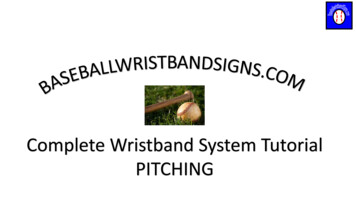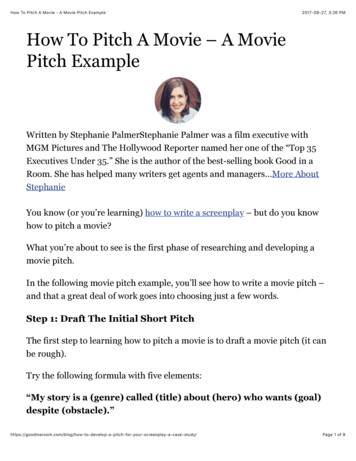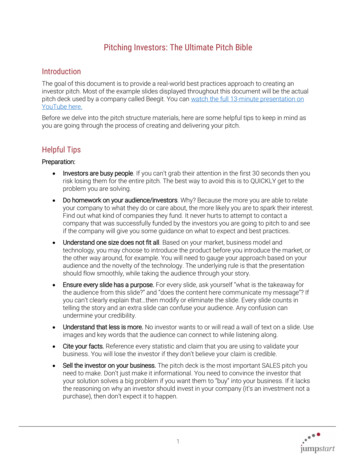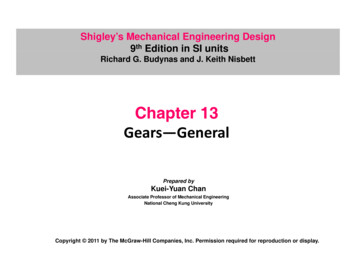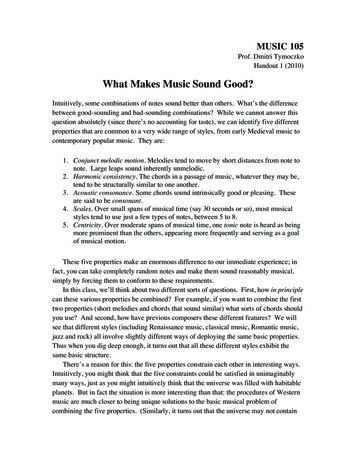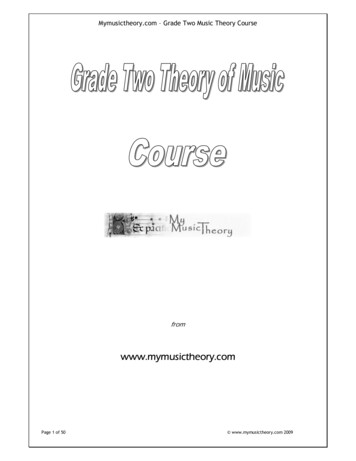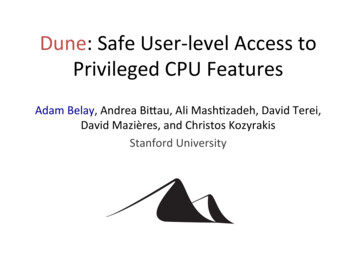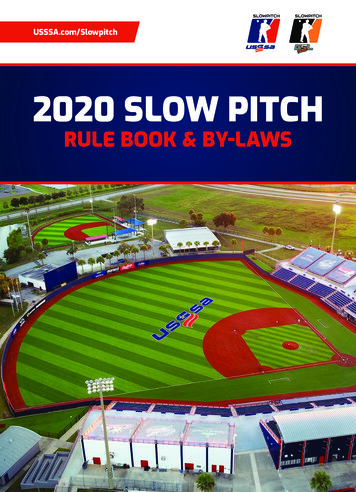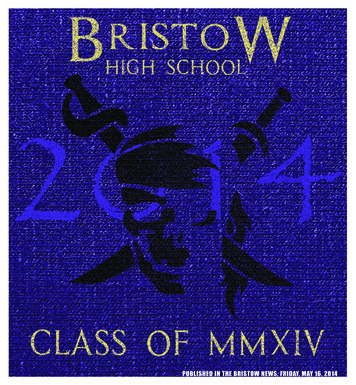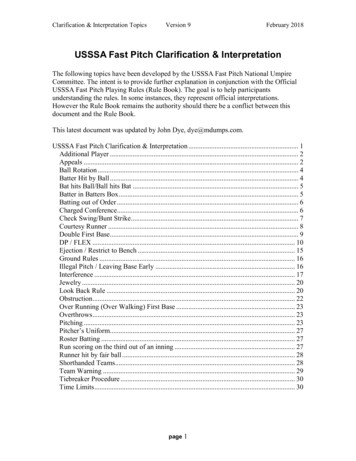
Transcription
Clarification & Interpretation TopicsVersion 9February 2018USSSA Fast Pitch Clarification & InterpretationThe following topics have been developed by the USSSA Fast Pitch National UmpireCommittee. The intent is to provide further explanation in conjunction with the OfficialUSSSA Fast Pitch Playing Rules (Rule Book). The goal is to help participantsunderstanding the rules. In some instances, they represent official interpretations.However the Rule Book remains the authority should there be a conflict between thisdocument and the Rule Book.This latest document was updated by John Dye, dye@mdumps.com.USSSA Fast Pitch Clarification & Interpretation . 1Additional Player . 2Appeals . 2Ball Rotation . 4Batter Hit by Ball . 4Bat hits Ball/Ball hits Bat . 5Batter in Batters Box . 5Batting out of Order . 6Charged Conference. 6Check Swing/Bunt Strike. 7Courtesy Runner . 8Double First Base . 9DP / FLEX . 10Ejection / Restrict to Bench . 15Ground Rules . 16Illegal Pitch / Leaving Base Early . 16Interference . 17Jewelry . 20Look Back Rule . 20Obstruction . 22Over Running (Over Walking) First Base . 23Overthrows . 23Pitching . 23Pitcher’s Uniform. 27Roster Batting . 27Run scoring on the third out of an inning . 27Runner hit by fair ball . 28Shorthanded Teams . 28Team Warning . 29Tiebreaker Procedure . 30Time Limits . 30page 1
Clarification & Interpretation TopicsVersion 9February 2018Additional PlayerIn a traditional lineup, a team may play with two (2) additional players (AP).The decision to use or not use addition player(s) is optional but it must be made beforethe start of the game.The AP can be substituted for and re-entered just like any other player.A team that uses additional players bats 10 (or 11) players for the entire game.In Roster Batting, a team must bat all players present by using as many AP as needed.There are no substitutes.Any nine (9) of the 10 (or 11) players in the batting order may play defensive.Players can change defensive positions at any time.Just as a player can change from shortstop to left fielder, the additional player can playdefensive at any position and that player sits out for all or part of the game.As long as a player is in batting order, she is in the game.AppealsAn appeal play is a play where the umpire does not make a ruling until requested by acoach or player.Types & Live Ball/Dead Ball Appeal Missing a base, advancing or returning – live ball or dead ball Leaving a base before caught fly ball is touched - live ball or dead ball Batting out of order – dead ball only Attempting to advance to second after overrunning first – live ball onlyA Live Ball appeal can be made by any fielder in possession of the ball. She can touchthe runner if the runner is still in field of play even if she is on another base. Or she cantouch the base missed or left too soon.A Dead Ball appeal is made while the ball is not live.Once all runners have finished running and time is called or if the ball goes out of playand runners had chance to finish running. The defense may make a may make a verbalappeal. Rule Book 10-2 states the pitcher announces the appeal. The accepted practice isany coach, manager or player with or without the ball may make a dead ball appeal.It must be clear what is being appealed.With multiple runners, the defensive must indicate which runner is being appealed.There does not have to be a verbal declaration. For example, with a runner leaving 1B onthe pitch; the batter hits a line drive directly to the second baseman who catches the balland immediately throws to the first baseman standing on 1B. This is a valid appeal of thepage 2
Clarification & Interpretation TopicsVersion 9February 2018runner leaving the base before a caught ball is first touched. The runner should be calledout.Appeals must be made before next pitch (legal or illegal) or all infielders have left fairterritory or all umpires have left field of play.A runner may not return to touch a base If reached base beyond and dead ball If left field of play If a succeeding runner has scored.More than one appeal play may be made but guessing games should not be allowed.EXAMPLE: If a runner misses (or nearly misses) two bases, the defense has the right toappeal both bases if the umpires run safe on the first appeal.If two runners tag and leave early, the defense could appeal both runners for leavingearly.SITUATION: B1 hits a slow roller to F5 and arrives safely but misses first base. F3catches the ball while standing on the first base after F3 has beaten the throw.RULING: If the runner passes first base before the throw arrives, she is considered tohave touched the base unless an appeal play is made. F3 must tell the umpire she'sappealing B1 missing first base before B1 returns to the base.Fourth Out AppealsBecause a run does not score if the third out of an inning is a force play and a runner doesnot score if a preceding runner is the third out, the defense may make an appeal after ithas recorded three outs as long as it is made properly.EXAMPLE: Bases loaded, two (2) outs. The batter hits a long ball between theoutfielders and attempts to run all the way home. She is thrown out at home for the thirdout of the inning. The defensive team then appeals that the batter runner missed first base.If the appeal is upheld, no runs would score.Note it is not a force when a runner leaves a base too soon on a caught fly ball and returnsin an attempt to retag. If this appeal play is the third out, it is considered a time play.Example with one out and R1 on third and R2 on first, a long fly ball is hit to the outfield.R2 leaves with the hit; R1 stays on third. The ball is caught. R1 leaves legally from third.F7 throws to F3. R1 touches home plate. F3 catches the ball while touching 1B. R2returns to 1B.R2 is out for the third out and R1’s run counts because she scored before R2 was out.No appeal can be made on the last play of the game once the umpires leave the field. Ifthere is a possible appeal by the defense, the umpires should wait until all defensiveinfielders have crossed the foul line on their way to the team dugout, before leaving theinfield. If teams line up for high fives there is little chance for an appeal even if thedefensive infielders have not crossed the foul line and umpires can leave the game at thispoint.page 3
Clarification & Interpretation TopicsVersion 9February 2018Ball RotationThe philosophy is to get all new balls used in the First Inning. This is to prevent putting anew ball in play late in the game.The pitcher has a choice of which ball to use at the start of each half inning. If both ballsdo not get into play in the first half of the first inning, the pitcher in the bottom half of thefirst inning MUST throw the unused ball. No choice is offered.After an inning is completed, the ball should be returned to the vicinity of the pitchingplate by the team leaving the field or the umpire. The pitcher taking the field now has aball with which to start the next half inning. The pitcher may request another ball fromthe plate umpire. The Umpire should get current ball and then give the pitcher a ball fromhis ball bag. The pitcher can not switch back.The current game ball should be used until such time as it goes out of play or becomesunplayable.Batter Hit by BallAny time a pitched ball or batted ball hits the batter, it is a DEAD BALL.It does not matter that the pitched ball hits the ground first.If the batter is swinging, Dead Ball; StrikeIf the ball is in strike zone or is prevented from going through strike zone, Dead Ball;Strike.If ball is out of strike zone and his the batter, Dead Ball; Batter is awarded first base.The batter does not have to make an effort to avoid ball.However the batter can not move to get hit by a ball. Dead Ball and a ball or strike.The hand is part of the batter. The hand is not part of the bat. If ball hits hand and bat simultaneously, Dead Ball. If batter not swinging and ballout of strike zone, batter awarded first. If ball hits bat and then hand, Dead Ball, Foul. If ball hits hand and then bat, Dead Ball as soon as it hit the hand.Batted Ball hits Batter – Dead BallIf a batted ball hits the Batter while she is still in the batter’s box, Dead Ball, Foul Balleven if the Batter is in fair territory.If the Batter/Runner has moved out of the batter’s box and unintentional contacts thebatted ball, Dead Ball. If the ball is in fair territory, she is out. If the ball is in foulterritory, it is a foul ball.page 4
Clarification & Interpretation TopicsVersion 9February 2018Bat hits Ball/Ball hits BatIf the bat is in the hands of the batter when the ball comes in contact with it a secondtime, it is a foul ball. Note by definition, the batter remains a batter while still in thebatter’s box.If the bat is in the hands of the batter-runner when the ball comes in contact with it asecond time, she is out and the ball is dead. Note by definition, the batter has become abatter-runner when both feet are completely outside the batter’s box.If the bat is in the hands of the batter when the ball comes in contact with it a secondtime, and The batter is still in the batter’s box, it is a foul ball. The batter has become a batter-runner (both feet completely outside the batter’sbox), she is out. The ball is Dead.If the bat is out of the batter’s hand (dropped or thrown) and the bat hits the ball in fairterritory, the ball is dead and the batter-runner is out.If the bat is out of the batter’s hand and the ball hits the bat on the ground, the batter isnot out. It is a fair or foul ball as follows: If the ball rolls against the bat in fair territory, it remains live. If it stops or is touched in fair territory, it is a fair ball. If it touches the bat in fair territory and then rolls to foul ground and stops, it is afoul ball. If the ball rolls against the bat in foul territory, it is a foul ball.Batter in Batters BoxThe batter is considered to be in the batter’s box waiting for a pitch when no part of eitherfoot is touching the ground outside the boundary lines forming the batter’s box.The lines of the batter’s box are part of the box. When taking a stance in the box, both ofthe batter’s feet shall be in the batter’s box. If any part of the batter’s feet is touching thelines, she is considered within the batter’s box.The batter shall be called out for being out of the batter’s box when at least one foot is onthe ground completely outside the lines of the batter’s box when the ball is hit. The batteris also called out when any part of a foot is touching home plate when she hits the ball.The ball is dead. The batter is out whether the ball is fair or foul.If no contact is made with the ball, there is no penalty.If there are no batter’s box lines evident, good judgment must be used and the benefit ofany doubt must go to the batter.page 5
Clarification & Interpretation TopicsVersion 9February 2018Batting out of OrderBatting out of order is an appeal play by the defensive.A batter is in proper order if he follows the preceding player in the lineup,A player is considered to be at bat as soon as he enters the batters box and one pitch hasbeen thrown.The defensive may appeal that the batter was not the correct batter until there has beenone pitch to the next batter.After one pitch, the defensive may only appeal that the current batter is not the correctbatter.If the current batter in the batter’s box with one pitch is not the correct batter,The correct batter is brought to bat and assumes the ball – strike countNo one is called out for batting out of order when there is a count on the batter.All advances made shall stand.If the batter who just completed her time at bat is not the correct batter, on appeal,The correct batter is declared out.The batter is removed from base.All outs made on other runners on the play stand.Any advance by runners on the play is nullified.No runs can score on the play.If the batter was out, the out will be rescinded because of the correct batter’s out.The next batter is the player who follows the correct batter (who was declared out) in thebatting order.All advances made before the batter became a batter runner shall stand.Charged ConferenceIt is a charged conference when time is requested for someone from the dugout tocommunicate with team members on the field.DefensiveThe defensive is charged with a conference when they request time and a coach (someonefrom the dugout) enters the playing field and communicates with any defensive player.However if the defensive informs the umpire that the pitcher is being removed before anyverbal communication, they should not be charged with a conference.The defensive is allowed three (3) charged conferences in a seven inning game.They are allowed one (1) and only one charged conference in each extra inning.Time granted to change pitchers does not count as a charged conference.page 6
Clarification & Interpretation TopicsVersion 9February 2018If there are any conferences exceeding the limit, the pitcher can not pitch any more in thatgame. The pitcher may remain in game at any defensive position other than pitcher.If the pitcher returns to the pitching position after being removed and one pitch has beenthrown, the pitcher is disqualified from the game.OffensiveThe offensive is allowed one (1) charged conference per inning.The umpires should refuse to grant the second conference. Penalty for excessiveoffensive conference is ejection.Time granted for injury does not count as a charged conference.During the other team’s conference or official’s time out, a team may confer withoutbeing charged. They must end when charged team’s conference ends.The plate umpire shall keep a record of defensive team charged conferences for eachteam.Check Swing/Bunt StrikeB1 starts to swing at a pitch but attempts to hold back, or it appears as though it is anattempt to bunt the ball. In either case, B1 misses the ball. How does the umpiredetermine what to call the pitch?A call of this nature is based entirely upon the umpire’s judgment. Therefore, the umpireshall, in order to be consistent, have guidelines to follow. The rule that most umpiresfollow is: If a batter swings halfway or more across the plate, it is a strike. In other words,if the bat is swung so it is in front of the batter’s body or ahead of it, it is a strike. The“breaking of the wrists” has sometimes been used as a guide. However, it is believedusing the first criterion will be more definite. In bunting, any movement of the bat towardthe ball, when the ball is over or near the plate area, is a strike. In 2009, the definition ofan attempted bunt changed. It is a strike if the bat is over the plate and the bat is not pullback from being over the plate. Holding the bat over the plate and not pulling it back isan attempt to bunt the ball. A strike should be called.First, was the pitch in the strike zone? If so, it is simply a strike.Second, did the batter swing at the pitched ball or in the case of a bunt attempt, did shemove the bat toward the pitched ball or hold the bat in the strike zone?If in doubt or if blocked out, the pitch should be called a ball. Umpires will not call thepitch a strike unless it was in the strike zone or the batter swung at the ball. If the umpirecalls the pitch a ball and the catcher requests help, the umpire should ask for help.page 7
Clarification & Interpretation TopicsVersion 9February 2018Courtesy RunnerThe coach may use any player who has not been in the lineup as a courtesy runner. Ifthere are no eligible unused substitutes, the coach may use the Last Completed At Bat(LCAB) as a courtesy runnerThe Pitcher and the Catcher are the last players to throw and catch a pitch.In the top of the first inning, the pitcher/catcher is the person listed on the line up card.A substitute or re-entered starter can not be considered a pitcher or catcher before playingdefense.A courtesy runner may be entered for a pitcher or catcher on base at any time. A courtesyrunner does not have to enter immediately after the pitcher or catcher gets on base.A player who has been taken out of the game can not be used as a courtesy runner.In general, a player can only be used as a courtesy runner once an inning. However if theteam bats around and the pitcher or catcher gets on base twice in the inning, the sameplayer can be use as a courtesy runner twice in the same inning.A player can not be a courtesy runner for both the pitcher and catcher in the same inning.A player can be a courtesy runner for both the pitcher and catcher in the same game.An unreported courtesy runner is treated the same as an unreported substitute. The teamis warned and further violations result in the ejection of the coach.If the courtesy runner is injured, she must be replaced by another courtesy runner or thepitcher or catcher for whom she is running.If the pitcher or catcher is placed on second base under the Tiebreaker Procedure, acourtesy runner can be used for her.If a pinch hitter reaches base and the pitcher or catcher re-enters, a courtesy runner maynot be used for her.In general, a player can not enter as a substitute in the same half inning that they are usedas a courtesy runner. However there is an exception for injury for a team that has no otheravailable substitute.page 8
Clarification & Interpretation TopicsVersion 9February 2018Double First BaseThe Double Base or Safety Base may be used at first base. It consists of the normal whitebase and a colored base the same size which extends into foul territory.The entire purpose of the Double Base is to avoid collisions at first base on close plays.On normal infield plays, the fielder is to use the white portion as she usually would. Thebatter runner is to use the colored portion to keep away from the fielder.On any out attempt from the foul side of first base, the defense can use either portion. Asthe purpose of the double base is prevent a collision, this exception is made so the fielderis not obligated to reach across the path of the batter runner to tag the white base nor isthe catcher compelled to throw across the path of the batter runner. In such an instance,the batter runner is allowed to go to the white portion of the double base.If there is no play at first base, as on a hit to the outfield, the batter runner may use eitherportion of the base.Once the batter runner reaches first base, she can return or tag-up on either part of thebase. Likewise, the fielders can tag any part of the base.In essence, once the batter runner reaches first base, it is one big bag that can be used byeither offense or defense.page 9
Clarification & Interpretation TopicsVersion 9February 2018DP / FLEXThe DP/FLEX replaces the DH rule.The primary role of the DESIGNATED PLAYER (DP) is to play offenseThe primary role of the FLEX is to play defenseThe optional DP/FLEX (and/or APs) must be listed on the lineup card that is approved bythe Plate Umpire.A team may have nine, ten, eleven or twelve starting players.A team may elect to include a DP/FLEX and/or up to two Additional Players (AP).The maximum number of players in the lineup is 12;The maximum number of batters in the lineup is 11.The DP/FLEX must be declared before game. Otherwise they may never be in the game.The DP’s name is listed where they are batting in the batting order. They can be in anyposition in the batting order.The FLEX is listed last in the lineup in a non-batting position.The DP must remain in the same position in the lineup for the entire game.page 10
Clarification & Interpretation TopicsVersion 9Any 9 players in the lineup can play defense.In general, the AP & DP are players who only bat.Any of the players in the line-up may play defense.page 11February 2018
Clarification & Interpretation TopicsVersion 9February 2018As long as the FLEX is in the last lineup position and has not replaced the DP,The FLEX can never play just on offense. If the FLEX is not on defense, FLEX is out ofgame.This eliminates the non-batting position.It reduces the number players in lineup.It must be reported.The DP may be substituted for at any time.The DP may re-enter.T he DP can never just play defense. If the DP is not on offense, the DP is out of game.The FLEX batting for the DP eliminates the non-batting position.The number in lineup is reduced.It must be reported.page 12
Clarification & Interpretation TopicsVersion 9The FLEX may be substituted for at any time.FLEX may re-enter.The DP or an AP may play defense for the FLEX.In either case, the FLEX will leave the game.The Non Batting Position can be Re-established.If the FLEX re-enters into the non batting position.If the DP re-enters and FLEX moves back into non batting position.The FLEX can only bat/run for the DP.The FLEX is ejected for batting/running for someone other than the DP.page 13February 2018
Clarification & Interpretation TopicsVersion 9February 2018The DP may play any defensive position, any time and any number of times. This doesnot count as a substitution for anyone except the FLEX which must be reported.The FLEX may play offense in the DP’s position any time and any number of times. Thisis a substitution for the DP which must be reported.The DP & FLEX can both be on defense at the same time.The DP & FLEX can NOT be on offense at the same.page 14
Clarification & Interpretation TopicsVersion 9February 2018No courtesy runner for DP.Unless DP is the pitcher or catcher of record.Ejection / Restrict to BenchAn umpire should always work hard to keep ‘em in the game.However when it is necessary, the umpire must invoke the proper penalty.When a coach or player is ejected, they must leave the area. Out of sight / out of sound.When a coach or player is restricted to the bench, they are not allowed to enter the fieldof play. However a coach, with umpire’s approval, may enter the field to tend to aninjured play. Restricting a coach to the bench does not constrain the coach fromcontinuing to coaching.It is often advisable to work with coach to control the spectators in the crowd.page 15
Clarification & Interpretation TopicsVersion 9February 2018Ground RulesThe field should be clearly marked. Markings should include screens on foul poles alongthe foul lines past first and third and vertical foul-line markings on any barrier that limitsthe outfield.Softball parks, as well as crowd and weather conditions, differ. Hence, it is sometimesnecessary to have special ground rules. The plate umpire must confer with the coachesprior to the game and then announce any ground rules on which the two coaches and theplate umpire agree. Ground rules may not supersede a rule in the USSSA Fast PitchSoftball Rule Book. If agreement cannot be reached, the plate umpire must establishneeded ground rules and announce them to both coaches.Here is a list of ground rules that are often adopted in cases where the field does not meetthe specifications as provided by Rule 2.If there is a screen behind the catcher or other permanent obstruction in front of the stand,a batted ball that goes behind these becomes dead. It is recommended that no suchobstruction be less than 25 feet from the diamond.Wild pitches, overthrows and batted balls that go over or through a fence or into a dugoutare governed by dead ball rules.For special field conditions, such as an incline that makes a spot where it is impossible orvery difficult for a fielder to safely retrieve the ball, the ball should become dead if itgoes to that spot and each runner’s advance should be limited to two bases.For an unfenced field, a chalk or imaginary out-of-bounds line should be established todefine live-ball area. If spectators are permitted in dead ball areas, umpires shouldconsider these the same as bleachers and the ball becomes dead if it bounces into thefans. The umpires must anticipate such a situation and announce the ground rule inadvance.Illegal Pitch / Leaving Base EarlyThe question comes what to do if you have an illegal pitch and a runner leaving baseearly on the same play. Since the illegal pitch is a delayed dead ball, play continues.However the runner leaving early is a dead ball. This ends the play and both penaltiesshould be enforced. The runner who left base early is out. The batter is awarded a ball forthe illegal pitch and any other runners on base would be awarded a base.Situation: bases loaded, one out and a 3-2 count on the batter. The pitcher went to theglove two times and the plate umpire has a illegal pitch (delayed dead ball) as the pitcherstarts her pitch the runner comes off first base. At that time, the base umpire calls nopitch. Penalty: Ball is dead; The runner on first base is out for leaving the base too soon.page 16
Clarification & Interpretation TopicsVersion 9February 2018The batter is awarded a ball which is ball 4 and is awarded first base. The runners onsecond base is awarded third base. The runner on third base is awarded home and scores.InterferenceInterference is an act that hampers the defensive.Interference is the act by an offensive player or team member that inhibits a defensiveplayer making a play. It may be in the form of physical contact, verbal distraction, visualdistraction, or any type of distraction that would deny the fielder a reasonable opportunityto execute a play. Defensive players must be given the opportunity to field the ballanywhere on the playing field or throw the ball without being hindered.Interference by an offensive player results in a Dead Ball and an Out.When interference by an offensive player or coach occurs, the ball is dead, someone mustbe called out, and all other runners are returned to the last base touched at the time of theinterference unless forced to advance.Batter InterferenceBatter Interference occurs while the batter is at bat and before she hits the ball. It takesplace when the batter: Intentionally interferes with the catcher’s throw on an attempted stealEFFECT: Dead ball; Batter is out; all runners must return to last base touched.EXCEPTION: If the batter is already out, the runner is also out. Interferes with the catcher on a play at the plate. The batter’s box is not asanctuary for the batter when a play is being made at the plate.SAME AS ABOVE Releases her bat in such a manner that it hits the catcher and prevents her frommaking a play. If the batter merely drops her bat and the catcher trips over it, thereis no interference.EFFECT: Dead ball; Batter is out; all runners must return to last base touched.If the catcher is not making a play on a base runner but the batter interferes with thecatcher’s return throw to the pitcher, the umpire should call time and return the runner(s)to the base occupied at the time of the accidental interference.Batter Runner InterferenceBatter Runner Interfere
SITUATION: B1 hits a slow roller to F5 and arrives safely but misses first base. F3 catches the ball while standing on the first base after F3 has beaten the throw. RULING: If the runner passes first base before the throw arrives, she is considered to have touched the base unless an appeal play is made. F3 must tell the umpire she's

